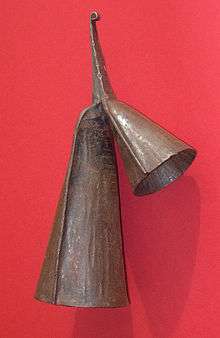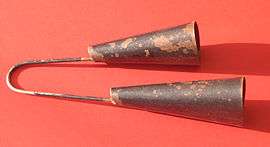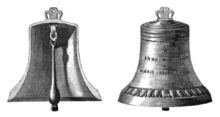Agogô
|
Modern agogo bell | |
| Percussion instrument | |
|---|---|
| Other names | gan gan (smaller version) |
| Hornbostel–Sachs classification |
111.242 (Bells) |
| Developed | Yoruba |
| Timbre | bright, uniform |
| Volume | medium to loud |
| Attack | fast |
| Decay | medium |
An agogô (Yoruba: agogo, meaning bell) is a single or multiple bell now used throughout the world but with origins in traditional Yoruba music and also in the samba baterias (percussion ensembles). The agogô may be the oldest samba instrument and was based on West African Yoruba single or double bells. The agogô has the highest pitch of any of the bateria instruments.
Construction
Each bell is a different size. This allows a differently pitched note to be produced depending on which bell has been hit. Originally wrought iron, they are now manufactured in a variety of metals and sizes for different sound qualities. The most common arrangement is two bells attached by a U shaped piece of metal. The smaller bell is held uppermost. Either bell may be hit with a wooden stick to make a cowbell like sound or less commonly a clicking sound is produced by squeezing the two bells together.
Religious origins
It is used in the ceremonial music of religions in Yorubaland as well as in their new world practice, which are based on beliefs brought by slaves from Africa such as candomblé. It may be officially used for congregation or heralding the coming of a dignitary. It is the main instrument of Obatala and Orisa Nla (Orisa Nla o, Alagogo Oje o). (Both Obatala and Orisa n la are very important Yoruba divinities).
Rhythmic patterns

Bell pattern 1 is the most basic, or archetypal pattern. It is the 4/4 form of what is known in ethnomusicology as the standard pattern, and known in Cuba as clave. Pattern 1 is used in maculelê and some Candomblé and Macumba rhythms. Bell 2 is used in afoxê and can be thought of as pattern 1 embellished with four additional strokes. Bell 3 is used in batucada. Pattern 4 is the maracatu bell and can be thought of as pattern 1 embellished with four additional strokes.
In rock music

David Byrne, lead singer of 1980s and 1990s rock band Talking Heads, has used the agogô on various albums and live in concert. Also, agogô bells play a distinctive role within drummer Neil Peart's solos during his live performances with the band Rush. A good example can be heard on "Light My Candle" from the 1996 musical Rent. Other examples are their use in the songs "Addicted To Drugs" by the Kaiser Chiefs and "Daft Punk Is Playing At My House" by LCD Soundsystem.
See also
References
External links
| Wikimedia Commons has media related to Agogô. |
| Look up agogo bell in Wiktionary, the free dictionary. |
 |
|
| Problems playing this file? See media help. | |
 |
African agogo
African agogo rhythm pattern |
| Problems playing this file? See media help. | |

